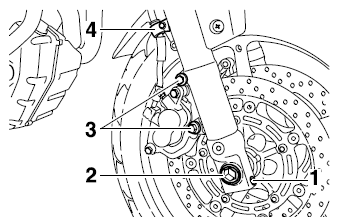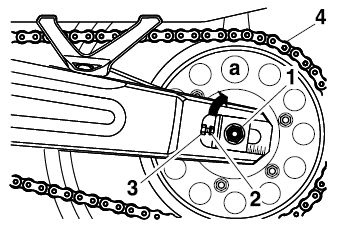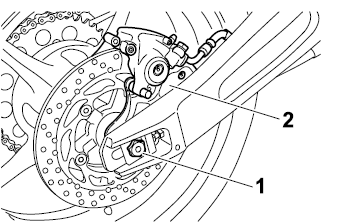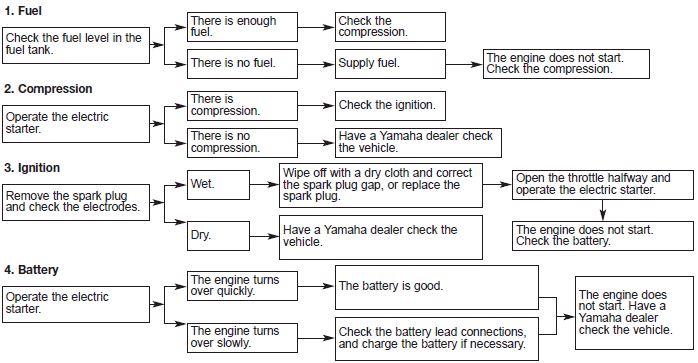 Yamaha MT-03 - Owner's Manual > Supporting the motorcycle
Yamaha MT-03 - Owner's Manual > Supporting the motorcycle
Since this model is not equipped with a centerstand, follow these precautions when removing the front and rear wheel or performing other maintenance requiring the motorcycle to stand upright. Check that the motorcycle is in a stable and level position before starting any maintenance. A strong wooden box can be placed under the engine for added stability.
To service the front wheel
1. Stabilize the rear of the motorcycle by using a motorcycle stand or, if an additional motorcycle stand is not available, by placing a jack under the frame in front of the rear wheel.
2. Raise the front wheel off the ground by using a motorcycle stand.
To service the rear wheel
Raise the rear wheel off the ground by using a motorcycle stand or, if a motorcycle stand is not available, by placing a jack either under each side of the frame in front of the rear wheel or under each side of the swingarm.
Front wheel
To remove the front wheel
WARNING
- It is advisable to have a Yamaha dealer service the wheel.
- Securely support the motorcycle so that there is no danger of it falling over.

- Front wheel axle pinch bolt
- Wheel axle bolt
- Brake caliper bolts
- Brake hose holder bolt
1. Lift the front wheel off the ground according to the procedure.
2. Loosen the front wheel axle pinch bolt, then the wheel axle and the brake caliper bolts.
3. Remove the brake hose holder on each side by removing the bolts.
4. Remove the brake caliper on each side by removing the bolts.
CAUTION: Do not apply the brake after the brake calipers have been removed, otherwise the brake pads will be forced shut.
5. Pull the wheel axle out, and then remove the wheel.
To install the front wheel
1. Lift the wheel up between the fork legs.
2. Insert the wheel axle.
3. Lower the front wheel so that it is on the ground.
4. Install the brake calipers by installing the bolts.
NOTE: Make sure that there is enough space between the brake pads before installing the brake calipers onto the brake discs.
5. Install the brake hose holders by installing the bolts.
6. Tighten the wheel axle, the front wheel axle pinch bolt and the brake caliper bolts to the specified torques.
Tightening torques:
Wheel axle: 72 Nm (7.2 m-kgf, 52 ft-lbf)
Front wheel axle pinch bolt: 14 Nm (1.4 m-kgf, 10 ft-lbf)
Brake caliper bolt: 40 Nm (4.0 m-kgf, 29 ft-lbf)
7. Push down hard on the handlebar several times to check for proper fork operation.
Rear wheel
To remove the rear wheel
WARNING
- It is advisable to have a Yamaha dealer service the wheel.
- Securely support the motorcycle so that there is no danger of it falling over.

- Wheel axle nut
- Drive chain slack adjusting bolt
- Locknut
- Drive chain

- Wheel axle
- Brake caliper bracket
1. Loosen the axle nut.
2. Lift the rear wheel off the ground according to the procedure.
3. Remove the axle nut.
4. Loosen the locknut on each side of the swingarm.
5. Turn the drive chain slack adjusting bolts fully in direction (a) and push the wheel forward.
6. Remove the drive chain from the rear sprocket.
NOTE:
- If the drive chain is difficult to remove, remove the wheel axle first, and then lift the wheel upward enough to remove the drive chain from the rear sprocket.
- The drive chain cannot be disassembled.
7. While supporting the brake caliper bracket, pull the wheel axle out, and then remove the wheel.
CAUTION: Do not apply the brake after the wheel has been removed together with the brake disc, otherwise the brake pads will be forced shut.
To install the rear wheel
1. Install the wheel and the brake caliper bracket by inserting the wheel axle from the right-hand side.
NOTE:
- Make sure that the retainer on the swingarm is inserted into the slot in the brake caliper bracket.
- Make sure that there is enough space between the brake pads before installing the wheel.
2. Install the drive chain onto the rear sprocket.
3. Install the axle nut, and then lower the rear wheel so that it is on the ground.
4. Adjust the drive chain slack.
5. Tighten the axle nut to the specified torque.
Tightening torque:
Axle nut: 150 Nm (15.0 m-kgf, 108 ft-lbf)
Troubleshooting
Although Yamaha motorcycles receive a thorough inspection before shipment from the factory, trouble may occur during operation. Any problem in the fuel, compression, or ignition systems, for example, can cause poor starting and loss of power.
The following troubleshooting charts represent quick and easy procedures for checking these vital systems yourself.
However, should your motorcycle require any repair, take it to a Yamaha dealer, whose skilled technicians have the necessary tools, experience, and know-how to service the motorcycle properly.
Use only genuine Yamaha replacement parts. Imitation parts may look like Yamaha parts, but they are often inferior, have a shorter service life and can lead to expensive repair bills.
Troubleshooting charts
Starting problems or poor engine performance
WARNING
Keep away open flames and do not smoke while checking or working on the fuel system.

Engine overheating
WARNING
- Do not remove the radiator cap when the engine and radiator are hot. Scalding hot fluid and steam may be blown out under pressure, which could cause serious injury. Be sure to wait until the engine has cooled.
- After removing the radiator cap retaining bolt, place a thick rag, like a towel, over the radiator cap, and then slowly rotate the cap counterclockwise to the detent to allow any residual pressure to escape. When the hissing sound has stopped, press down on the cap while turning it counterclockwise, and then remove the cap.

NOTE: If coolant is not available, tap water can be temporarily used instead, provided that it is changed to the recommended coolant as soon as possible.
See also:
 Yamaha MT-03 - Owner's Manual > Replacing the headlight bulb
Yamaha MT-03 - Owner's Manual > Replacing the headlight bulb
Headlight coupler Headlight bulb cover Headlight bulb holder Headlight bulb

 Benelli Imperiale 400
Benelli Imperiale 400 BMW F900XR
BMW F900XR Honda CB500X
Honda CB500X KTM 390 Adventure
KTM 390 Adventure Triumph Street Triple S
Triumph Street Triple S Yamaha MT-03
Yamaha MT-03 Kawasaki Z400
Kawasaki Z400 Triumph Street Triple S
Triumph Street Triple S Yamaha MT-03
Yamaha MT-03